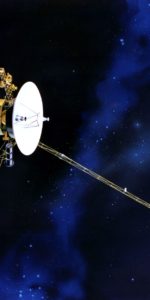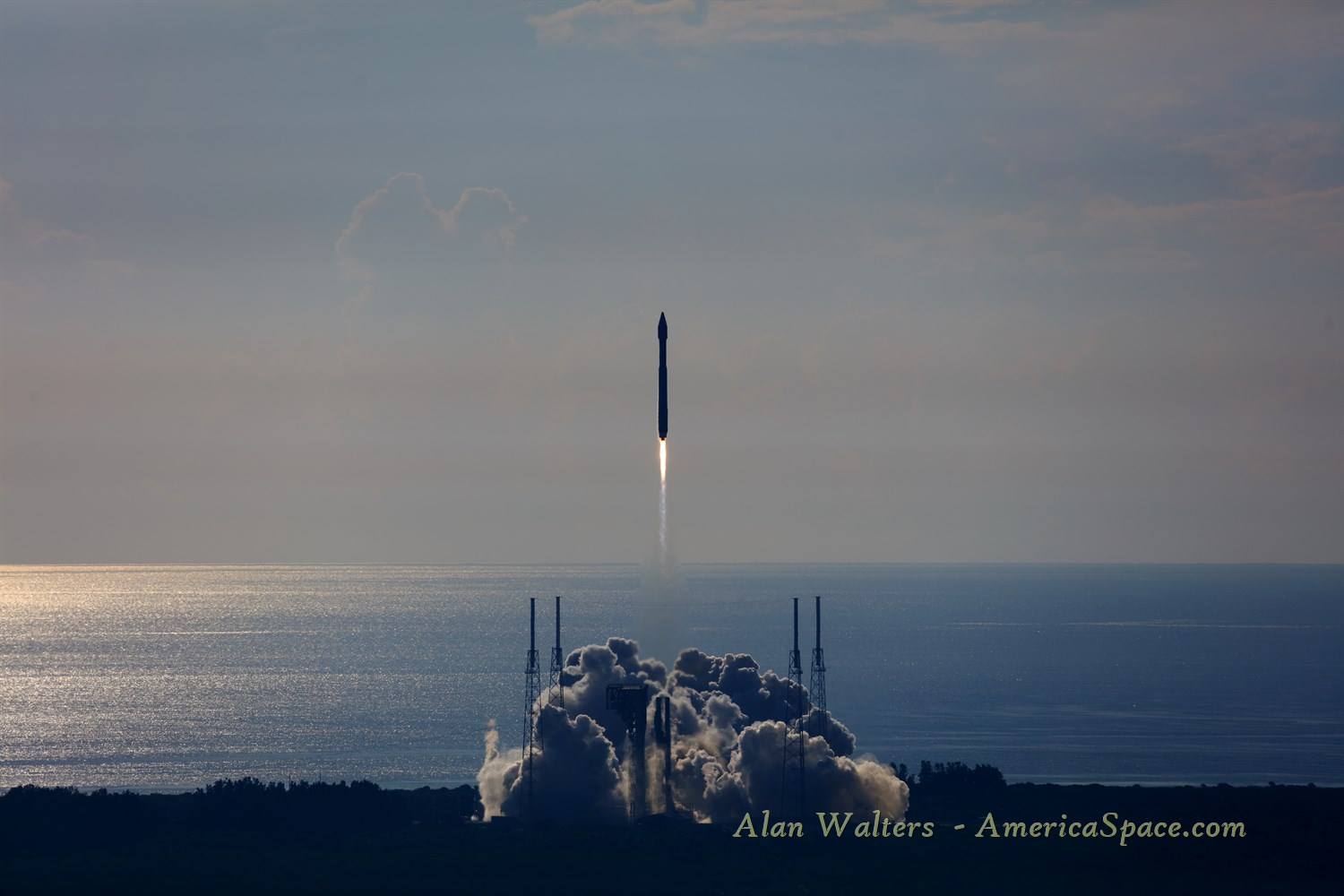
United Launch Alliance (ULA) successfully delivered the latest member of NASA’s Tracking and Data Relay Satellite System (TDRSS) into Geostationary Transfer Orbit (GTO) earlier today (Friday, 18 August), following a smooth countdown. The workhorse Atlas V booster—flying in its “barebones” 401 configuration, equipped with a 13-foot-diameter (4-meter) payload fairing, no strap-on boosters and a single-engine Centaur upper stage—roared away from Space Launch Complex (SLC)-41 at Cape Canaveral Air Force Station, Fla., at 8:29 a.m. EDT, halfway through today’s 40-minute “window”.
After four months on the ground, today’s launch places the Centennial, Colo.-headquartered ULA in pole position to accomplish four more missions before year’s end—including three missions in September alone—to close out 2017 on nine flights, its lowest annual tempo since 2010. To date this year, ULA has delivered the classified NROL-79 payload into orbit on behalf of the National Reconnaissance Office, together with the latest members of the Wideband Global Satcom (WGS) network and the Space-Based Infrared System (SBIRS) geostationary element. Most recently, on 18 April, an Atlas V lofted Orbital ATK’s OA-7 Cygnus cargo ship to the International Space Station (ISS), executing the first launch under ULA’s recently-unveiled RapidLaunch architecture.
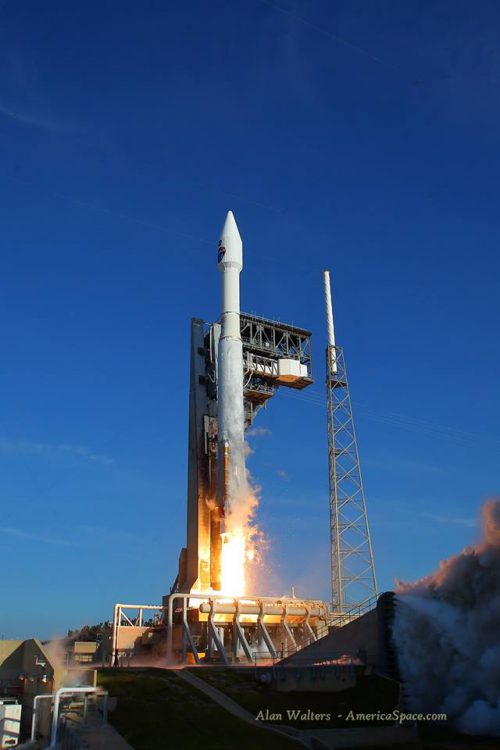
As outlined in AmericaSpace’s TDRS-M preview article, today’s mission has not been unaffected by gremlins. Last month, during pre-flight closeout activities, the satellite incurred S-band Omni antenna damage, which necessitated replacement and additional testing. In response, the launch slipped by two weeks past its original 3 August target date. Still, the 122-day downtime between OA-7 in April and TDRS-M today represents the widest gap between launches in ULA’s decade-long history, soundly eclipsing the 91 days which elapsed between Atlas V and Delta II flights in March and June 2007.
According to ULA, the expansive gap between launches is not out of the ordinary. “We stand poised to launch when our customers are ready,” the organization told AmericaSpace. Added ULA CEO Tory Bruno, it reflected “just an odd quirk in satellite deliveries”.
With the completion of this fifth flight of 2017, four more missions are targeted to fly before year’s end. Three are slated for September/October—with the NROL-42 mission for the National Reconnaissance Office and the National Oceanic and Atmospheric Administration’s (NOAA) long-delayed Joint Polar Satellite System (JPSS) due to rise from Vandenberg Air Force Base, Calif., as well as the NROL-52 classified payload from the Cape—and NROL-47 due to bookend the year with a mid-December launch from the West Coast. Nine flights in a single calendar year is the lowest number for ULA since 2010, which achieved eight missions.
Following the encapsulation of the 7,615-pound (3,450 kg) TDRS-M in its 14-foot-wide (4-meter) Extended Payload Fairing (EPF), earlier this month, the stack was transported out to the Vertical Integration Facility (VIF) at SLC-41 and installed atop the Atlas V. When fully assembled, the pencil-like booster stood an impressive 191 feet (59 meters) tall and was rolled the quarter-mile (400-meter) distance to the pad on Wednesday, 16 August. Present to witness the rollout was George Morrow, deputy director of NASA’s Goddard Space Flight Center (GSFC) in Greenbelt, Md., which carries oversight for TDRSS.
Upon arrival at the SLC-41 surface, umbilical and electrical and data connections were established, as efforts got underway to fuel the Atlas V. The first propellant to be loaded was “storable” RP-1, a highly refined form of rocket-grade kerosene, although the cryogenics—liquid oxygen and hydrogen—for the Atlas V’s Common Core Booster (CCB) and Centaur upper stage were tanked on launch day. All told, some 44,000 gallons (200,000 liters) of liquid oxygen and 10,580 gallons (48,100 liters) of liquid hydrogen were loaded aboard the 191-foot-tall (58-meter) booster.
Backdropped by a 70-percent-favorable weather outlook—tempered by a risk of violating the Thick Cloud Rule and Cumulus Cloud Rule, on account of seabreeze-induced showers and isolated thunderstorms—ULA teams pressed ahead with readying the Atlas V for flight. With the conclusion of fueling, the countdown entered its second 30-minute built-in hold at 7:29 a.m. EDT, at which point the clock stopped at T-4 minutes. It was expected that the clock would resume counting at 7:59 a.m., producing an on-time liftoff at 8:03 a.m.
During this period, with all propellant tanks verified at flight levels, the liquid oxygen transitioned to “topping” mode, whereby the boiled-off cryogens were continuously replenished until close to T-0. However, at 8 a.m., ULA reported a slight delay. “Extending the hold at T-4 minutes by 5 minutes,” it tweeted, “to evaluate an issue with pressurization in the Centaur upper stage engine.” The issue centered on the Centaur’s liquid oxygen chill-down system. “As we were chilling the Centaur engine down, we noticed one of the chill-down parameters on the thermal conditioning for the LOX side was not quite getting cold enough” in time to permit liftoff at 8:03 a.m., NASA Launch Manager Tim Dunn explained.
With Friday’s window due to close at 8:43 a.m., time was of the essence, as ULA, NASA and associated teams worked to co-ordinate a revised T-0. At length, at 8:18 a.m., ULA announced a new launch time of 8:29 a.m. The Launch Team issued a unanimous “Go” across the board, allowing the count to emerge smoothly from the hold at T-4 at 8:25 a.m. In the final phase, propellant tanks were pressurized and the Flight Termination System (FTS)—which would destroy the rocket in the event of an accident—was placed onto internal power and armed.
Two-and-a-half seconds before T-0, the Russian-built RD-180 engine of the Atlas V’s core roared to life, quickly ramping up to produce 860,000 pounds (390,000 kg) of thrust from its dual nozzles. “Climb-out” from the pad commenced at T+1.1 seconds, as the booster barreled vertically upwards for a few seconds, before the Centaur avionics commanded a pitch, roll and yaw program maneuver to establish it onto the correct flight azimuth to inject the TDRS-M payload into orbit.
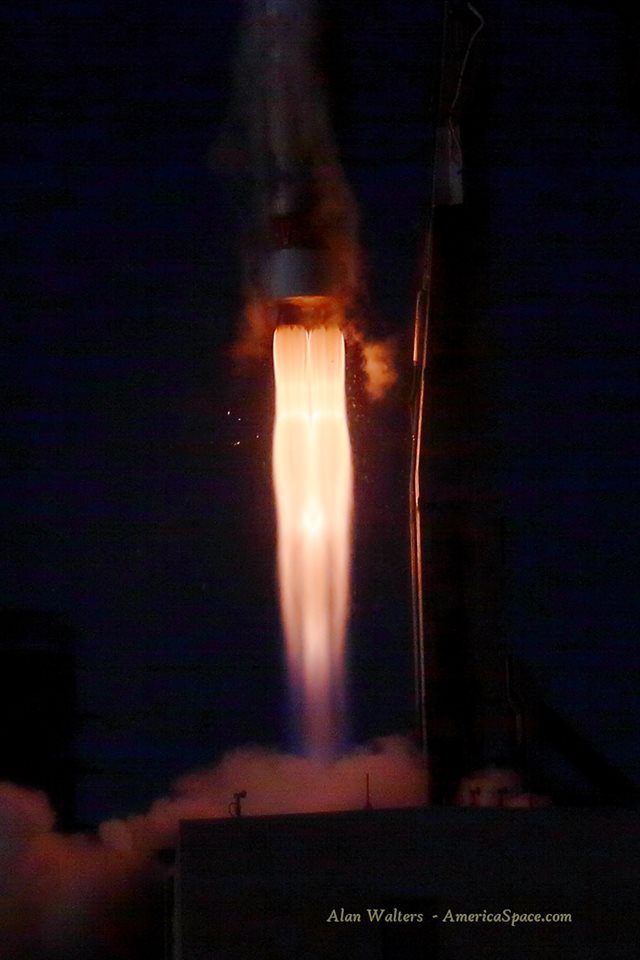
Passing the speed of sound about 80 seconds into ascent, the Atlas V soon encountered maximum aerodynamic turbulence (colloquially dubbed “Max Q”) on its airframe. The RD-180 continued to burn hot and hard, before finally shutting down at 8:33 a.m. EDT, about four minutes after liftoff. The spent CCB was then jettisoned, leaving the powerful Centaur in charge of executing two critical “burns” to deliver TDRS-M into its targeted orbit, with an apogee at geostationary altitude.
Six seconds after CCB departure, the Centaur’s Pratt & Whitney Rocketdyne-built RL-10C engine ignited, generating a propulsive yield of 22,900 pounds (10,390 kg). It burned continuously for 13.5 minutes, during which time the payload fairing was jettisoned to expose TDRS-M to the space environment for the first time. With Main Engine Cutoff-1 (MECO-1) at 8:46 a.m. EDT, the combined Centaur/payload combo occupied an elliptical “parking orbit”, where it coasted for a further 90 minutes. This coasting phase allowed the stack to gradually gain altitude, whereby the second Centaur burn would establish an apogee at geostationary altitude.
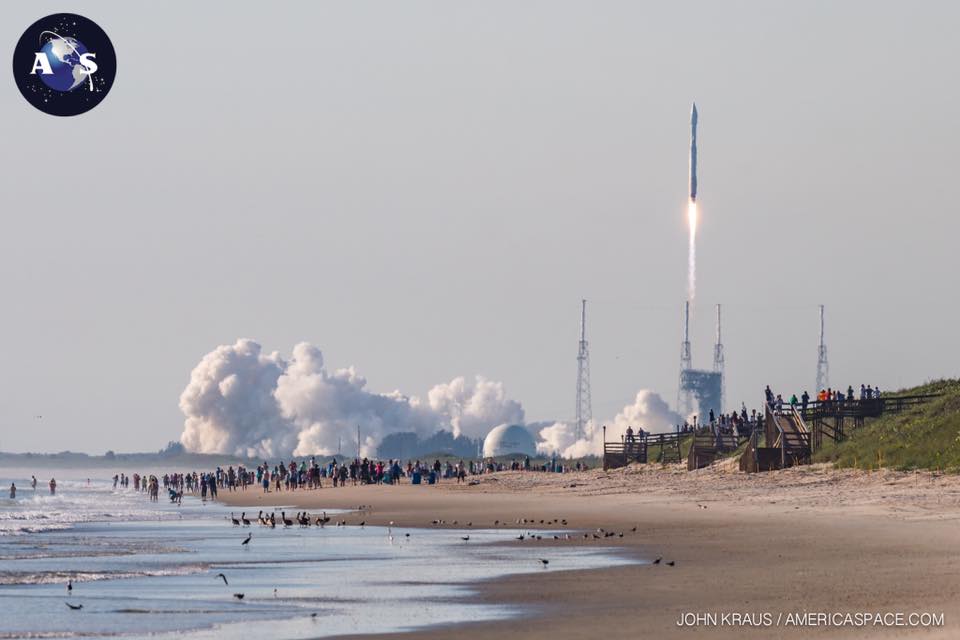
That second burn got underway on time at 10:17 a.m. EDT, a little under two hours since leaving Cape Canaveral. Although it was a brief firing—only a minute in duration—it played a critical role, establishing TDRS-M in a highly elliptical orbit with a perigee of 2,883 miles (4,640 km) and an apogee at geostationary altitude of 22,237 miles (35,786 km). Four minutes after the Centaur shut down for the final time, NASA’s latest communications satellite was separated to commence its mission. “Spacecraft separation is the best part of the launch campaign,” said Mr. Dunn. “So many hours are put into getting to this exact point when you know you have a healthy satellite that just separated from the launch vehicle, about to go do its intended mission.”
Over the next ten days to two weeks, TDRS-M will utilize its on-board propulsion system to raise its perigee to geostationary altitude. It will then unfurl its electricity-generating solar arrays and communications payload. It will be initially situated at 150 degrees West longitude, approximately over Hawaii, where it will embark on an on-orbit testing program, lasting between three and six months. “The current plan is to relocate the spacecraft to 49 degrees West longitude after acceptance and place it into operational service,” Dewayne Washington of NASA-Goddard told AmericaSpace.
Be sure to “LIKE” AmericaSpace on Facebook and follow us on Instagram & Twitter!
.
Missions » TDRS »




